Textile Lovers Rejoice!
Our exciting India Textiles and Taj tour is back for 2025! Travel to the fabulous textile-producing states of Gujarat and Rajasthan.
Join expert guides and fellow textile lovers Behind the Scenes to discover the incredible variety of Indian textiles in the western region.
First we’ll drop by the Taj Mahal with our expert guide. No trip to India is complete without seeing this marvel of art, architecture, and love! Then we’ll visit the rescued bears at the Agra SOS Wildlife Center. We’ll head west to Jaipur, then Ahmedabad, and north to Kutch, then to the crafts-rich area of Bhuj. In the city of Bhuj, we’ll see historical palaces such as the fabulous Hall of Mirrors in the Aina Mahal Palace. We will also visit ancient temples and other architecturally fascinating sites such as the Rani Ki Vav stepwell.
We’ll meet textile artists everywhere and make beautiful creations with them. Two different block-print artists will teach us the intricacies of printing with hand-carved blocks. A tie-dye or bandhini master will explain how to stitch and dye a stunning silk scarf. And when we visit the Rabari women of the remote Dasada region, they’ll show us how to incorporate little round mirrors called shisha into a piece of embroidery. Silk ikat weavers and a pit-weaver will demonstrate their skills too!
Finally we will fly from Bhuj to Mumbai, see the city sights, spend the night to relax, and then connect with our flights home the next day. During the trip, we’ll travel by private van and plane, and stay in fascinating Heritage hotels, even a Majarajah’s palace!
TRIP HIGHLIGHTS
- The Taj Mahal
- Visit the homes of textile experts and view their superb collections
- See the heartwarming Bear Rescue Center run by the NGO Wildlife SOS
- Print, stamp, and dye your own fabric and learn Rabari embroidery in our textile workshops
- Travel with local textile guides, experts in each region and meet textile masters
- See the elegant wild asses of the Little Rann of Kutch.
BEGIN YOUR ADVENTURE
An Overview of Your Journey
Taj Mahal and Bear Rescue
The two UNESCO sites of the Taj Mahal and the Agra Fort begin our trip in grand style. We’ll visit the Taj at sunrise for the best light. The exquisite Taj was commissioned in 1632 by the Mughal emperor, Shah Jahan to house the tomb of his beloved wife, Mumtaz Mahal. The tomb is the centrepiece of a 42-acre complex and is set in formal gardens.
Near Agra we’ll visit the Agra Bear Rescue Center, managed by the wonderful and caring SOS Wildlife team. This center is home to over two hundred Sloth Bears rescued from horrific lives as dancing bears, or from poaching and situations of man-animal conflict. The facility is the world’s largest, and is truly a heart-warming place, with bears playing with balls, lounging on tire swings and in rope hammocks.


Delhi to Jaipur
Next we’ll go by van to Jaipur, and check into our lovely royal palace. In Jaipur, we’ll visit many interesting places including the excellent Anokhi Printing Museum for a great introduction to our workshop of wooden block-printing! In a nearby village, we’ll visit an old friend and expert block print artist for a complete introduction into block-printed or stamped fabric. At his studio, we’ll all print 2 yards of light cotton cloth suitable for clothing, a tablecloth, or a pareo/scarf, below.
Jaipur also has a large branch of the famous FabIndia store where you can get hand-made home furnishings such as pillows, or little girl’s dresses, or inexpensive and good quality Indian-style kurtas and pants for yourself. Everything in the store is made in India; FabIndia links over 55,000 craft-based rural producers to modern markets, giving economic empowerment to disadvantaged rural women.
Printing Workshops
Textile artists are happy to open their studios and as we meet them along our route, we’ll learn detailed techniques of the traditional dyeing and printing processes. First is a visit to Bagru where woodworkers carve slabs of wood with intricate designs to make the printing blocks. And we can watch some of the artists stamping patterns onto cotton fabric, before we start our first project. In a nearby studio we’ll print pareos or light cotton wraps with our choice of designs.
Later at an Ajrakh resist-printing workshop, we’ll see how various resists and dye baths of indigo, madder and other natural substances make different color combinations. In another town, we’ll meet dyers who will show us how to make our own beautiful silk bandhini-style tie-dyed scarves. You can make an exquisite scarf that you’ll be proud to wear at home. There may be an opportunity to purchase some of the artists’ beautiful work also.
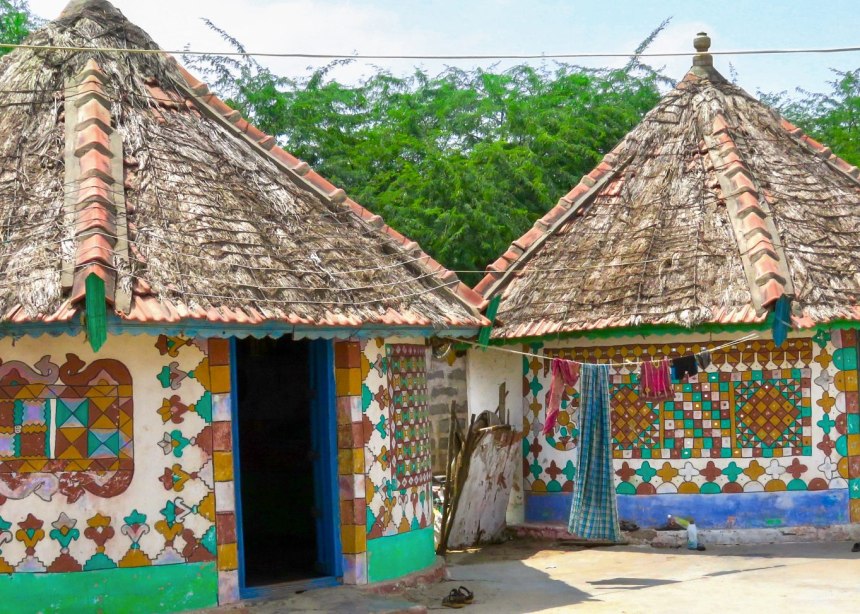


Astronomy and Ikat Weavers
Also in Jaipur we’ll see the ingenious astronomical observatory called Jantar Mantar; it was completed in 1734. It features the world’s largest stone sundial, and is a UNESCO World Heritage Site. At this fascinating place we’ll learn about how the brilliant early scientists studied the universe. The Jantar Mantar is a collection of 19 astronomical instruments built by the Rajput king Sawai Jai Singh, the founder of Jaipur. The nineteen instruments allow the observation of astronomical positions with the naked eye and are used for measuring time, predicting eclipses, tracking the location of major stars as the Earth orbits around the Sun, and more. Jaipur also is known for a good selection of silver jewelry so anyone interested can stop by one of the shops on our free time.
Our great guide knows all the textile artists and collectors, so there will be some surprise visits! We’ll fly from Jaipur to Ahmedabad, where an expert Indian textile guide and old friend will meet us. Next we will see the historical city of Ahmedabad, the guide’s home town. He will take us on a fascinating heritage walk around the old quarter and to see the famous textile collection at the Calico Museum.
Also on this route is a visit to meet the famous silk ikat weavers of Patan. The Salvis’ ikat is double, meaning that both the warp and the weft have resist patterns tied and dyed in, to make a design when aligned correctly. The Salvi family has perfected the ikat tying, dyeing and weaving methods. They will show us how they bind the silk threads so the rich dye colors don’t penetrate the bound areas – and how they weave the complex patterns. In their hometown of Patan, the Salvi family has established a private museum of the ikat technique with fabrics from all over the world. (They welcome donations too if you have ikat cloth from another country and don’t know what to do with it!) For special events wealthy women wear the Salvis’ exquisite silk ikat saris that cost thousands of dollars.
Stepwells
Near Patan is Rani Ki Vav, the Patan Step-well, a stunning structure built by Queen Udaymati, the wife of Bhimdev. It is the best example of such architecture for water wells that are unique to Gujarat. There are carved images in the niches of this multi-storied step well. It was one of the largest and the most sumptuous structures of its type. Our superb guide has done extensive research on typical Indian step-wells and as we travel, he will show us the importance and prevalence of the most important of these. We’ll drive to Dasada, sleep in earthen bungalows and bounce over the Kutch in an open Jeep to see the elegant Wild Asses and amazing bird life. We can visit some Banni villages in this area and see their intricately decorated clothing and fine embroidery. Anyone interested can sit with the women and learn embroidery stitches.


On to Bhuj and Bhujodi
We’ll also see Bhujodi, a village of artists skilled in traditional bandhani (tie-dyeing), block printing and weaving. We’ll meet textile designers here and see their work. And in the city of Bhuj, we’ll meet more artisans and see historical palaces such as the Aina Mahal. The great master piece of the artist Ramsingh is the hall of Mirrors in the Aina Mahal. The walls are white marble covered with mirrors and lit by exquisite chandeliers.
Finally we will fly from Bhuj to Mumbai, see the city sights, spend the night to relax, then connect with our flights home the next day, the 19th of March.
Some of our hotels for this trip…

Little Rann of Kutch Bungalows
In this country setting, comfortable thatched-roof adobe bungalows are set around a central garden. Walls are decorated with geometric mud and mirror designs, made by local women. A large open building holds the restaurant where we’ll eat, before and after exploring the surrounding nature preserve. We’ll have an open Jeep safari from here, to see the elusive and elegant wild asses and abundant bird life.

Shahpura House
Shahpura House’s classic elegance will make us feel like royalty. The comfortable and spacious rooms are furnished with period furniture. The heritage palace offers utterly traditional Rajput hospitality amid modern amenities. The present owner, Maharaj Surendra Singh, is a descendant of the royal family of Shahpura and has restored the exquisite building in the most traditional manner.
Additional Details & Experiences

Incredible West Indian Food
The people of Gujarat State have perfected the art of vegetarian cooking. And in nearby Rajasthan, the population counts about 75% vegetarians which makes it the ‘most vegetarian’ state in India.
A complete and balanced meal called a thali is the most popular lunch, like Indian comfort food. Thali consists of many little dishes of vegetable mixes, yoghurt, and perhaps mango pickle, always served with dal (lentil soup) and rice. The breads eaten with a thali might include thick and coarse bajra rotla, thin unleavened wheat rotis, thick and crisp whole wheat flour rotis called bakhris, stuffed parathas, or deep-fried puris.
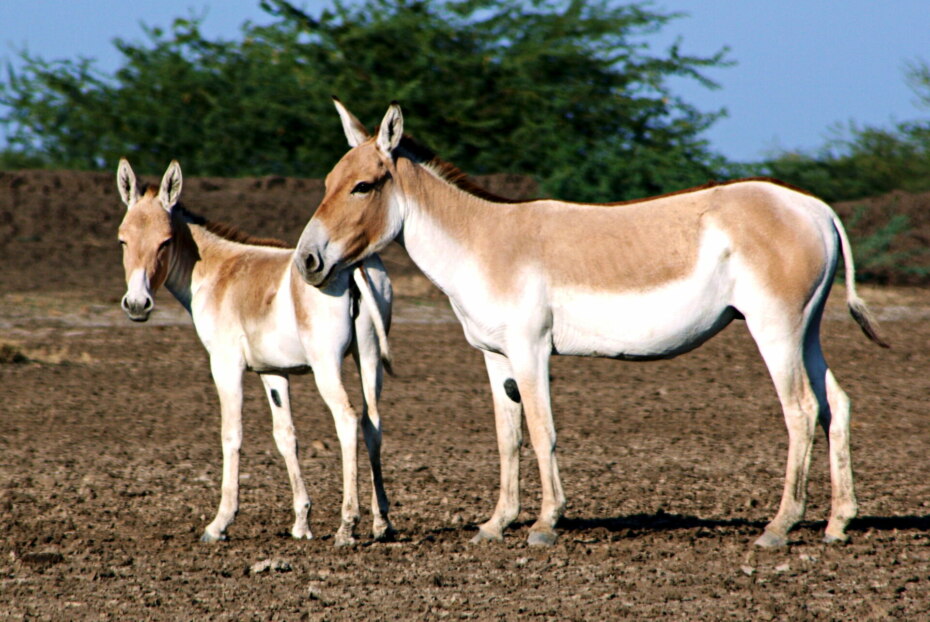
Wild Asses of Kutch
The Little Rann of Kutch in Gujarat State is home to the world’s last population of the elegant wild ass (Equus hemionus khur). Its color is a warm brown-ish tan with white underparts and a dark mane and stripe running along the back.
The Rann is one of the most remarkable and unique landscapes of its kind in the world, and it’s listed on UNESCO’s Tentative List for natural heritage.
The Indian wild ass is a subspecies of the onager native to South Asia. It is currently listed as Near Threatened, but due to concerted conservation efforts, the population has now reached over 6,000, according to the census conducted in March 2020.

Indian Embroidery
Embroidery is the most important textile decoration technique in the western states of Gujarat and Rajasthan. Women of ethnic groups such as the Rabari learn to stitch as girls, and later create clothing with a large variety of fine, intricate stitches. Small round mirrors are often stitched onto cloth with special stitches that add to the embroidered accents. Thread colors are most typically deep golden yellow, red and white on white, red or black cotton fabric. The women make colorful embroidered blouses for themselves and their little girls. We will have the opportunity to learn some stitches and to insert small round ‘shisha’ mirrors into our sample embroidery.
Photos From Previous Adventures


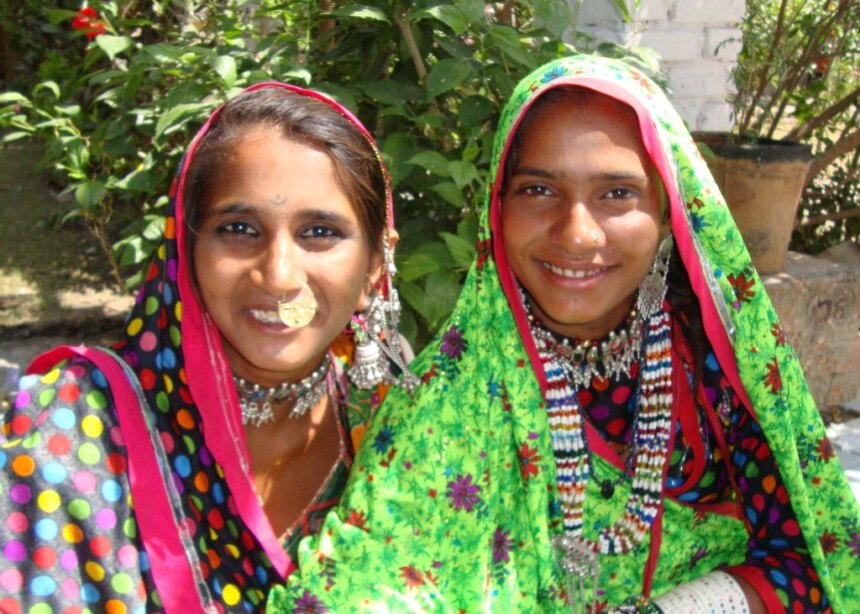
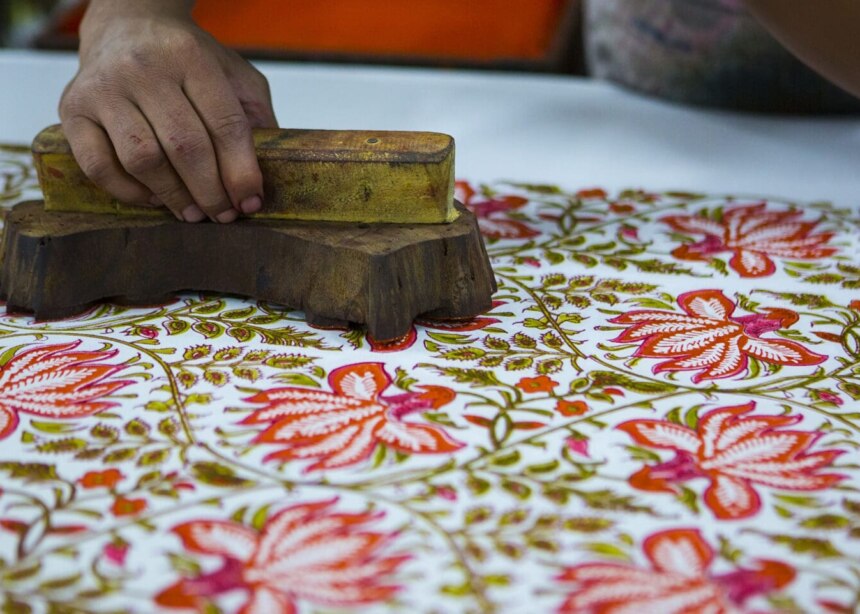





Your Trip Leaders

Nirav
Nirav lives in Ahmedabad and is an expert in textiles. He knows all the textile artisans in western India and they welcome him -and by extension us – with open arms. Nirav is a strong proponent of organic local cotton, and will point it out in the fields. He designs and tailors his own clothing from the soft cotton fabric. In fact he has just started a functional clothing business with organic cotton fabrics. He has photographed, discovered and researched many of the ancient step-wells of India, another one of his passions.
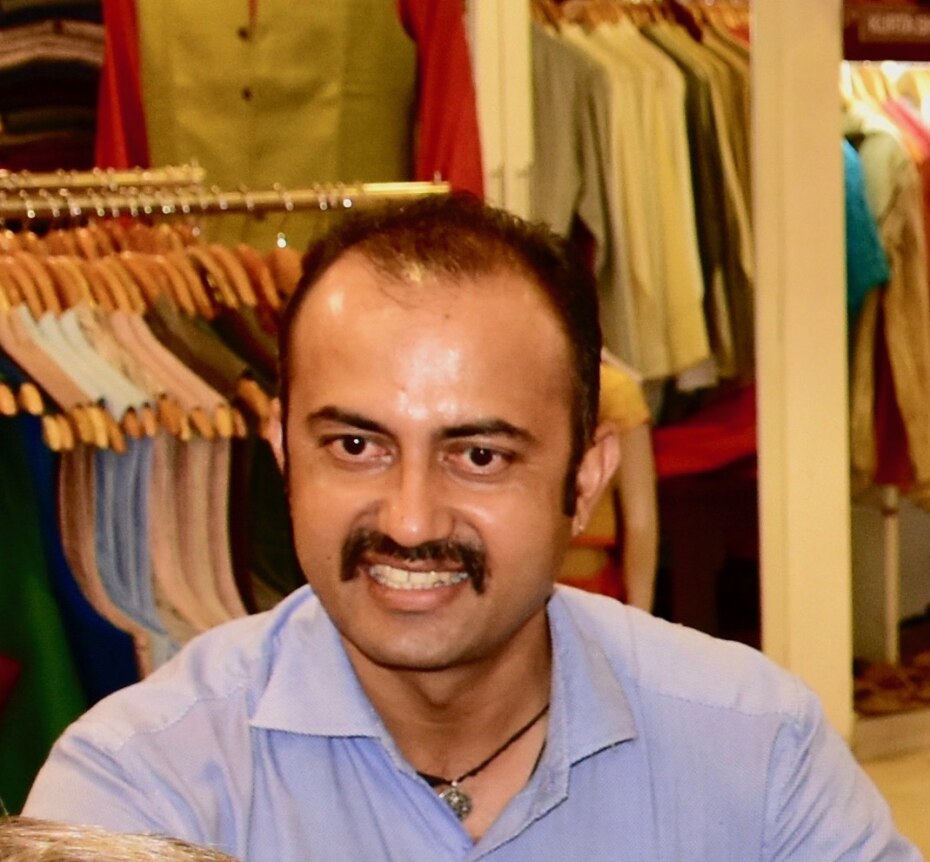
Sher Singh
Sher is an experienced guide who specializes in New Delhi and Jaipur. He’ll be with us while we visit the sites of Jaipur–until we fly to Ahmedabad where Nirav will take over. Sher is multi-talented, from expounding on the region’s history and culture to patiently waiting while we shop and ask his opinion of various outfits we try on at the local FabIndia store!

Cynthia
Cynthia began “Behind the Scenes Adventures” to share with others the traditional textiles and festivals of far-flung countries. Since 1998 she has led small groups of textile fanatics and friends all over the world. She accompanies all the tours for her “woman-owned” business. Desiring some new locations and new types of textiles, she has branched out in recent years to discover many other wonderful destinations for Behind the Scenes tours.
Check Trip Availability
Trip signups are accepted on a first-come, first serve basis. Please provide your details below and we’ll be in touch to confirm whether spaces are still available for this trip. If you need to get in contact, please email: info@btsadventures.com
Registration Information
- Dates: March 3 – 18, 2025
- Fly Home Date: March 19, 2025
- Deposit: $500
- Tour Cost: 16 Nights From $5725
- Single Supplement: $995
For more information:
Phone: 707-939-8874
E-mail: info@btsadventures.com
Read: Frequently Asked Questions
Travel Plans
We’ll meet in New Delhi, drive to Agra to see the Wildlife SOS Bear Rescue Center and the Taj Mahal. Then we circle the north/west by van and plane. To avoid back-tracking, we will fly to Mumbai, then fly home from there.
The itinerary for the Textiles of India tour has been carefully planned to cover a lot of ground, but also not to move around every night. We spend 2 or 3 nights in some destinations where we will have workshops or other interesting experiences.
Visas
We will send you information on how to apply for an easy online electronic visa for India.
What’s Included
- 16 nights accommodation (double rooms with private bath) in elegant heritage hotels, modern hotels in cities, and charming local bungalows in remote areas.
- All meals and tea breaks, water/tea/coffee and soft drinks/juice with meals.
- Local transportation in good vans with professional drivers.
- All workshops and supplies: Block-printing, Indigo dyeing, tie-dye on silk, etc.
- Interior flights to see as much as possible in our time frame.
- Bottled water on road trips.
- All village visits and museum entrances as on itinerary.
- All temple and cultural site visits as on itinerary.
- Airport arrival and departure transport (on group arrival and departure days).
- Professional English-speaking local guides, with experts on textiles of India.
- Textile expert Cynthia Samaké to accompany the tour.
- Luggage porter tips.
What’s Not Included
- International airfare.
- Visa for India; information will be forthcoming.
- Recommended travel and trip cancellation insurance (Allianz.com; Travel Guard, World Nomad, etc.)
- Alcoholic beverages.
- Tips for guide and driver. Tipping Guidelines will be sent with trip information.
- Between-meal snacks and water; we will have complementary bottled water in the van on travel days.
- Camera/video fees if required (rarely).
